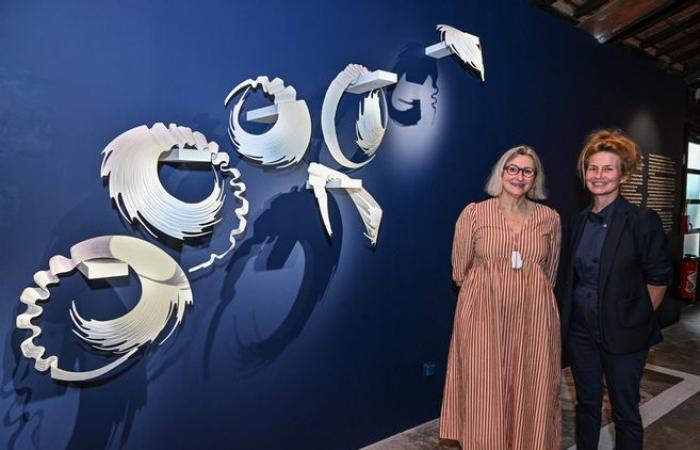Thirteen artists are exhibiting at the Fondation Bernardaud, in Limoges, until March 29, 2025. Internationally recognized artists, some of whom have never presented their creations in France. Guided tour.
The exhibition offered by the Bernardaud Foundation is a dive into theAbsolute. A title that opens up possibilities with the works of 13 internationally known artists. Their common point: having a privileged, tenacious relationship with the material.
All, without exception, very quickly said yes to participate in this new exhibition which takes place until March 29, 2025, on Avenue Albert-Thomas, in Limoges, and most of them created pieces specially. It must be said that the Bernardaud Foundation, for years, has become beyond our borders, a sure value for artists who love creative freedom.
“When you work for the Bernardaud Foundation, nothing is imposed on you, you have immense freedom. As a curator, it’s very comfortable. With Hélène Huret, the director of the Foundation, we reached an agreement, we had real shared favorites for certain artists,” notes the exhibition curator, Stéphanie Le Follic-Hadida. What is also extremely pleasant for an external curator is not to feel limited in the choices. It’s extremely rare. There are people here that I really aspired to be able to exhibit in my career. Thanks to this exhibition, I had the opportunity to really bring together artists of great renown.”
Stéphanie Le Follic-Hadida intervened three years ago for the exhibition Ambiguous beauties. A hyper figurative exhibition. “It was a bit trashy, on a very contemporary line. »
She, who worked for a long time at the Rodin museum, needed to rediscover a sculptural language, with confrontations with questions of material, space, and the environment. “Looking at the global context, I needed something else on a personal level and I told myself that I should not be the only one to feel this need for a respite, for a contemplation, a need for a little of poetry. »
Receive our leisure newsletter by email and find ideas for outings and activities in your region.
Or when contemporary works of art speak of our relationship to the world…
Valérie Hermans
This ceramist, who practiced calligraphy assiduously and who was fascinated by Chinese painting from a very young age, was nourished by this meticulousness, this look at nature, the finesse of the line and more generally this culture .
“The absolute for me is this idea of using a language with a very precise, very elaborate technique. »
empty (empty)
Her small enameled ceramic pots, created from a very common material, iron, have different colors and play with light. The French artist flirts with the poetic universe. “Iron does not have the same color if it is more or less thick… The idea is to play with the marvelous, the relationship with animals, the poetry of childhood.” Also see her porcelain biscuit tiles inspired by cut-out books, the “pop-ups” of the 50s.
Christian Gonzenbach
Nine pieces from his Hanabi series (Fireworks in Japanese) are presented at the Foundation. The artist takes cheap vases and partially destroys them to confront two contradictory forces, the container and the explosive force of metal at 800 degrees. “I asked myself what could happen by bringing these two forces together. » The answer lies in these extremely powerful creations. The molten metal passes through the ceramic, exploding the vase, but holding the pieces together. This play between the aluminum and the fragmented, frozen ceramic produces a disturbing effect. The cast aluminum extends the flower designs on the vase.
“Perhaps this is why I work, to bring to light things that I myself had not foreseen and which also surprise you. »
empty (empty)
Jun Kaneko
“We have total admiration for him. He shows admirable perseverance,” notes the exhibition curator. Born in Japan, he left at the age of 20 for a residency in the United States, a country from which he never left. This artist comes from the world of painting and discovered American abstract expressionism before turning to ceramics. “When I discovered these works, I was moved to tears,” says the curator. The massiveness of the proposals, the natural drips appearing during cooking, the roundabouts, squares, zigzags, concentric lines that he creates are a pictorial vocabulary all his own. His strength: never having been absorbed by any artistic movement.
Maria Oriza Pérez
A work that is both rigorous in its creation but lyrical and flamboyant with its cast shadows, its patterns and its depth of field. The Rose of Timespresented by the artist Maria Oriza Pérez, symbolizes this duality and offers the illusion of a botanical blossoming.
Steven Heinemann
“His works left me speechless. They are extremely sensitive and refined,” says the curator about Steven Heinemann. This Canadian artist refuses to distinguish between functional and artistic ceramics. For him, ceramics must not deny its history, remember its very utilitarian past. Steve says he pays particular attention in his creations to the contrast between the softness of the exterior and the roughness of the interior.
“I fail a lot. Very often. But it allows me to always try something else. What do I expect in creation? Let a miracle happen. »
empty (empty)
Some of these miracles are exhibited in Limoges.
Toshio Matsui
Very famous design professor in Japan, Toshio Matsui also created pieces specially for the Fondation Bernardaud exhibition. He explores the contrast between the clayey, very earthy part of his work which he covers with a layer of lacquer, forming a sort of mirror.
This sophistication contradicts the rusticity of the base and echoes this ancestral Japanese art where kitchen objects, utilitarian, were covered with urushi lacquer. The artist who venerates these materials drew his inspiration from… archaeological excavations to better reinterpret the lacquered pottery created more than 5,000 years ago. An impression of majesty and serenity undeniably emerges.
Paula Bastiaansen
Specifically created for the exhibition, his porcelains combining lightness and strength are admirable.
“I am very honored to be invited. This search for movement is very difficult to explain,” said artist Paula Bastiaansen. “I prefer my work to speak for me…”
empty (empty)
The Dutch artist uses the bone china developed in England at the end of the 18th century which, as its name suggests, uses bone powder (from beef shanks) to promote the transparency of creations. With these light, almost aerial proposals, the artist has won an incredible number of awards around the world. “It’s crazy work. We think it’s unachievable and ultimately, she offers us a dynamic work, comparable to no other,” summarizes the exhibition curator.
David Regan
He was wildly successful, but produced very little. Two figurative and eminently political creations are presented at the Foundation. “At the start, he was totally in the world of the reminiscence of the functional object. For nearly 20 years, he produced, for example, cutlery and then switched to a purely sculptural object without any further reference to this functionality. »
The two figurative pieces by this American artist are sumptuous and cannot fail to challenge us. “When you walk past them, you see a swarm of details, but you don’t really understand the meaning of the reading. And you proceed a bit by rebus. You see chimneys with smoke coming out of them, clusters of houses, an American city, planes, cars, cows, wagons, etc.” Overconsumption and environmental issues are represented with impressive detail. He uses a technique known in ceramics, sgraffito, which consists of covering the piece with a black slip before using a stylus to make the whites of the outlines of the drawing reappear. You just have to get closer to see the delicacy of the execution. “Such precision is just amazing,” enthuses the exhibition curator. His work is being presented for the first time in France.
Yu Tanaka
The works of Yu Tanaka in the foreground, with those of the ceramicist Jean Girel behind
This Japanese artist offers work of “unparalleled sensitivity and power”, according to the exhibition curator. His illusionist sculptures give the impression of a knotted textile, a reference to Japanese culture where gifts are carefully wrapped. The yellow color, with nuances in the folds, was worked on at length by the artist. Reference to the yellow inside of bowls in Japan and to fabrics which, in the past, were dyed with turmeric. She uses particularly plastic clay to offer, after such long and delicate work, a stunning result. The visitor wonders what object is inside. The illusion is perfect.
And also
Also worth discovering are the pieces by Jean Girel, made of bursts, tears and lifting of matter. “In France, he is our national enameler,” notes the commissioner. We will also focus on the creations of Yasuo Hayashi, one of the most important precursors of abstraction in contemporary Japanese ceramics and on the very colorful pottery of Peter Pincus who is presenting his work for the first time in France.The pottery of Peter Pincus
Also worth seeing are the exuberant and controlled ceramic sculptures of Asuka Tsuboi.
Practical. Single price of 3 euros (included in the purchase of a classic visit ticket). Access times to the exhibition between 10:30 a.m. and 11:30 a.m. (last entry of the morning) and from 1:30 p.m. to 4:30 p.m. (last entry of the afternoon).
Franck Lagier





